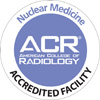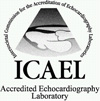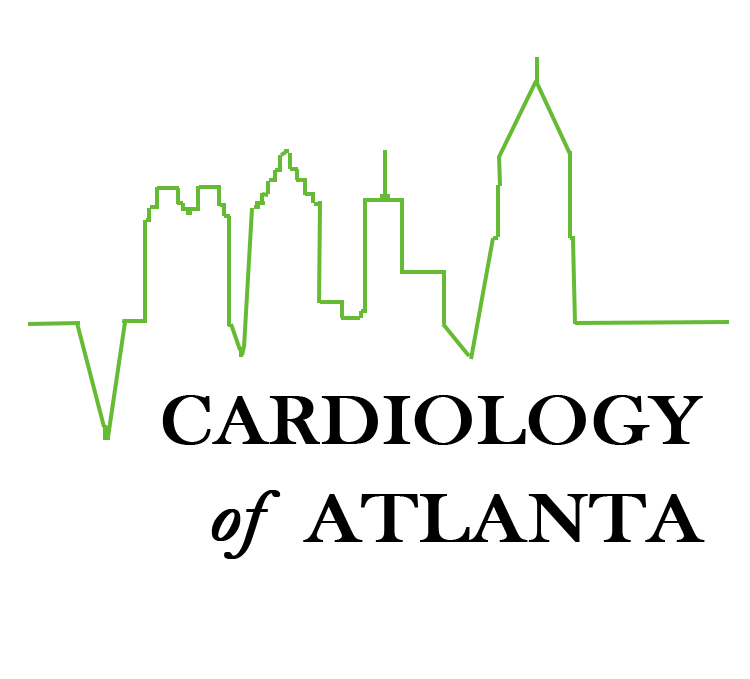Cardiology Services and Procedures
Below is a list and brief description of the procedures and services offered by Cardiology of Atlanta.
Striving To Cover All Your Medical Needs
We offer a full complement of outpatient cardiology testing services at our Sandy Springs office, supervised by highly trained and certified professional technologists and staff. This includes exercise stress testing, nuclear perfusion imaging, transthoracic echocardiography, and cardiac rhythm monitoring. Hospital-based testing is performed at both Emory St. Joseph’s Hospital and Northside Hospital-Atlanta and includes cardiac catheterization and percutaneous intervention, cardioversion, and transesophageal echocardiography. We welcome Spanish-speaking patients and have a physician and several staff members who are native speakers.
Electrocardiogram, or simply EKG, is a test to measure the electrical signal generated by the heart from the surface of the chest wall. This requires placing 12 electrodes, or stickers, on the skin of the chest wall and connecting them to a machine that reads the heart rhythm for approximately 10 seconds. It is the most common cardiac procedure and provides your doctor information about heart rhythm, electrical conduction through the heart, cardiac size and wall thickness, and can detect the presence of heart attacks.
These vascular ultrasound studies are similar to echo in that sound waves are used to image parts of the body. These studies assess the blood flow in the large vessels in the neck and the abdomen/pelvis. These arteries are much larger in size than coronary arteries and ultrasound is a useful technique to visualize atherosclerotic plaque within the vessel and determine if the patient has narrowing present. Patients with coronary artery disease, histories of smoking, diabetes, hypertension, and elevated cholesterol are at particular risk for developing blockages in these peripheral arteries.
Nuclear stress testing is an office-based test that is used to evaluate whether there are significant blood flow problems in the heart muscle due to blockages in the coronary arteries. The patient has two sets of pictures taken of the heart in an open camera, one immediately after exercise and a second during rest. The images are used to compare the relative blood flow to the heart under rest and stress conditions. Exercise is usually accomplished using a treadmill but for patients who cannot walk on the treadmill, we use a “chemical stress test” where a medicine is given that simulates exercise by dilating the heart arteries. The images are created using a small amount of a radioactive tracer injected into the bloodstream which travels to the heart muscle and emits energy that can be detected using the nuclear camera. Information about the blood flow to the heart muscle is obtained and differences between the rest and stress images can indicate if there are sections of heart muscle that are not receiving enough blood or may have been previously damaged as a scar. Nuclear stress testing is also as myocardial perfusion imaging and is sometimes referred to as “thallium test” due to an isotope that can be used during imaging. Patients must be fasting to complete this study and may not be able to use certain common cardiac medications that slow the heart prior to the test. Full written instructions will be provided before the examination.

Cardiac catheterization is an invasive test used to directly analyze the coronary arteries (the arteries that provide blood flow to the heart muscle) for blockages. This technique uses long thin tubes called catheters, which are about the size of a spaghetti noodle, and are introduced into the body while the patient is under light sedation to remain comfortable. A needle is used to access the artery in the wrist or in the groin and a small plastic sheath is introduced that allows the catheter to move smoothly through the blood vessels toward the heart. The catheter is used to measure pressures inside the heart chambers and blood vessels, and IV contrast dye is injected into the coronary arteries while an external X-ray camera obtains live action pictures of the dye flowing through the vessels. The results from this study allow your doctor to obtain very precise anatomic images of your coronary arteries to determine if there are significant blockages that may require coronary intervention. A diagnostic cardiac catheterization takes approximately 30 minutes to complete and the results are available immediately. When coming to the hospital for cardiac catheterization it is recommended for the patient to bring a relative or friend as driving is not allowed the same day after receiving sedation. In most cases, cardiac catheterization is an outpatient procedure from which the patient will be discharged home the same day.
CT is a radiographic test that uses X-rays to image the body in multiple “slices” which can be reconstructed in 3-dimensions using computers. Cardiac CTA uses an injection of intravenous contrast, like that used in cardiac catheterization, with subsequent CT imaging to visualize the insides of the coronary arteries. These are the vessels which bring blood flow to the heart muscle and can become clogged leading to a heart attack. This test can visualize plaque build-up and calcium in your coronary arteries and help your doctor plan how to best treat atherosclerosis. CTA also gives information about the structure of the heart. CTA is not for everyone. It is used in patients who have had chest pain with an unclear source or when other types of cardiac stress testing do not give clear answers. Patients who have an irregular heart rhythm or impairment of kidney function impairment may not be able to undergo cardiac CTA. This test can be performed as an outpatient and takes only about thirty minutes to complete.
A coronary artery calcium score is another CT based test involving X-ray images of the chest looking specifically for the presence and degree of calcification in the arteries of the heart. This is a low-cost imaging test offered through most major hospital systems and takes only a few minutes to complete. It is used as a screening evaluation to help your doctors further assess your risk for developing blockages in the heart arteries. It is often recommended to patients in the middle years of life who have CAD risk factors such as a family history of heart disease, high blood pressure, elevated cholesterol, diabetes, or tobacco exposure.
Slice x-ray images of the chest are reconstructed in a computer to give the result of the patient’s calcium score, which is reported in Agatston units, and result in a percentile rank compared to a matched demographic group of patients. A score of zero means that there is no evidence of calcified plaque in the arteries, although that does not necessarily exclude the presence of soft noncalcified plaque.
Scores up to 400 define the presence of plaque in the arteries and the higher the score is, the higher the risk for the possibility of an obstructed vessel. Your doctor will want to aggressively manage CAD risk factors with medications and likely complete baseline stress testing for scores in this range. Scores over 400 are very elevated and impart a high risk warranting a more detailed clinical evaluation and sometimes even lead to cardiac catheterization.
Transthoracic Echocardiography, or simply echo, is an office-based examination that uses reflected sound waves to create images of a patient’s heart and blood vessels. The test is performed using an ultrasound probe placed against the chest wall and usually takes about 30 minutes to complete. Information about heart structure and function can be obtained including heart size, valvular function, ventricular function or “squeeze” of the heart, and an estimation of pressures inside the heart. Patients with emphysema or those who are very obese or have very large chests may have poor quality studies and be better imaged by other means. A hospital-based version of echo is done known as transesophageal echocardiography, or TEE, and is a similar test but is performed from inside the body. This study is done by introducing an endoscopic transducer through the mouth that the patient swallows under sedation. It is often used when regular echo does not answer the question, because TEE can provide more detailed images of the heart chambers, the heart valves, and the great vessels arising from the heart. It is often used to more thoroughly evaluate for infection of the heart valves, cardiac masses or clots, abnormal communications between chambers, and diagnose aortic dissections. Patients cannot eat prior to the test but can take home medications with sips of water. The test is done in a hospital setting and the patient will need a relative or friend to drive home because it is done with sedation.

This study is used to evaluate if symptoms that a patient is feeling may be due to narrowing or blockages of the coronary arteries. The patient is monitored using continuous electrocardiogram and intermittent blood pressure measurements while exercising on a treadmill machine. The treadmill gets progressively faster and steeper every 3 minutes, for the purpose of increasing the patient’s heart rate to at target goal, based on age. To prepare for this test, wear comfortable clothes and tennis shoes and be ready to exercise. It is best not to eat a heavy meal prior to performing a treadmill test.
Ambulatory EKG monitors and Mobile cardiac telemetry monitors are devices used to provide your doctor information about the heart rhythm over a longer period of time than an EKG provides. The device is a small “sticker patch” that is placed on the front of the chest wall and communicates to a cell-phone like transmitter. The device can be worn to analyze the heart rhythm for anywhere from 24 hours to 30 days at a time. The patch stays on the skin during the test and you should be able to shower with it in place. Monitors can detect arrhythmias and help correlate symptoms patients experience. Symptoms of palpitations, heart racing or syncope (passing out) are often assessed with heart monitors. The results of the monitor will help your doctor choose the proper treatment to manage the cardiac rhythm.
MRI is a method of imaging the body that uses a large, “doughnut-shaped” magnet that a patient is placed into during the exam. The magnet creates an alignment of a subatomic particle the proton (or hydrogen ion) contained in the body’s water, and then measures how fast these protons return to their relaxed state. Cardiac MRI used to create very detailed images of the tissue of the heart and blood vessels. A wide variety of cardiac conditions can be examined using Cardiac MRI including coronary disease, congestive heart failure, valvular heart disease, congenital heart disease, and vascular disease. Not everyone can undergo an MRI. Patients who are severely claustrophobic may have difficulty, but sedation can be used to help patients relax during the test. Anyone with implanted metal in their body, such as certain pacemakers, defibrillators, cerebral aneurysm clips, and cochlear implants, cannot have an MRI. MRI is performed on an outpatient basis and can last up to an hour, depending on the condition being examined.
Pacemakers are small electronic devices, about the size of an old silver dollar coin, which can generate and deliver the electrical signals necessary to initiate the cardiac contractions. This device is surgically implanted beneath the skin in the upper chest wall, below the collarbone, and wires are placed through the veins to connect into the heart. These procedures are performed at the hospital by a specialist called an electrophysiologist (EP). Your doctors at Cardiology of Atlanta work closely with many EPs at the hospital and can help facilitate this type of care through a referral. Pacemakers are necessary when the natural electrical system in the heart is failing and can be used to treat patients who have symptoms caused by a very slow heart beat. In most cases, pacemakers are implanted during a minor surgical procedure, needing only local anesthesia and moderate sedation. The pacemaker has two components a generator or “battery” which is the part implanted beneath the skin in the chest wall, and the leads, which are very thin cables or wires that connect the generator to the heart chambers and transmit the electrical signal produced by the generator. The generator is much more than a battery; it is a very sophisticated micro-computer that can tell when the heart beat is slow or fast and will monitor the heart’s own electrical signals and deliver its own electrical signals to help the heart contract. In most cases, a pacemaker implant can be completed in under an hour, often as a same-day surgery.


